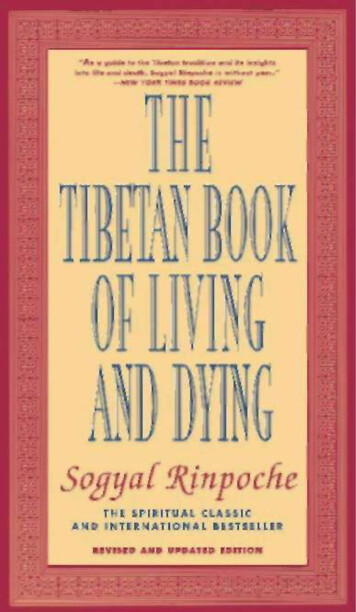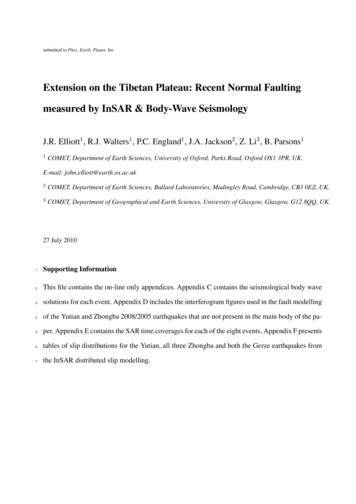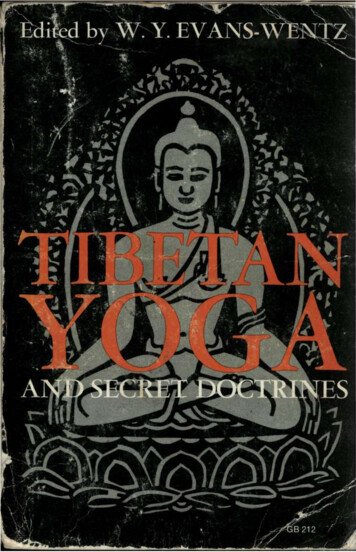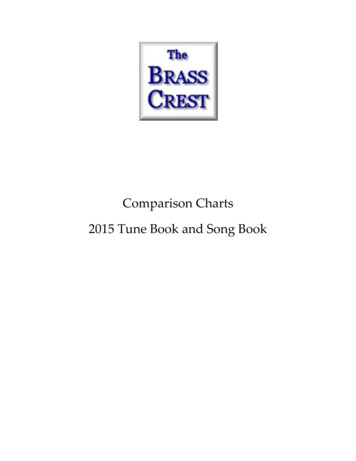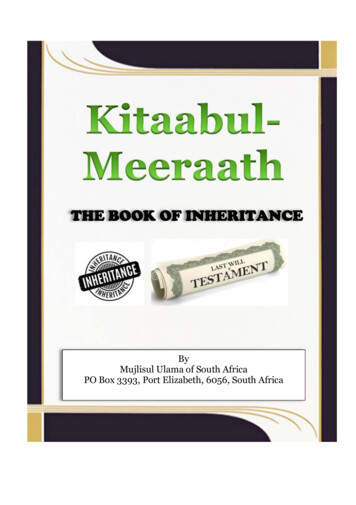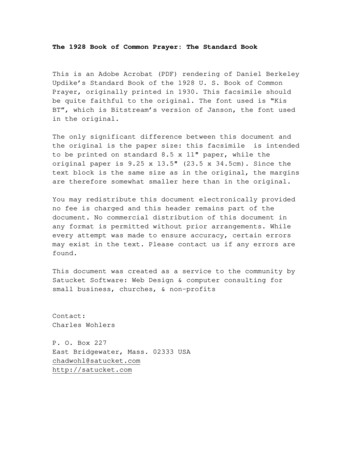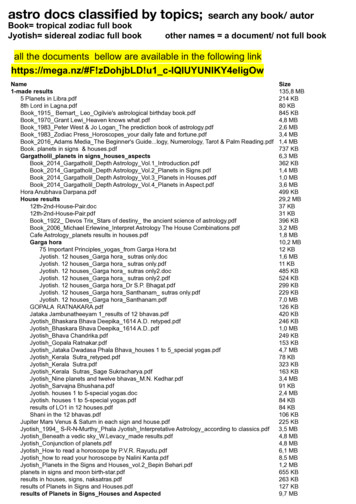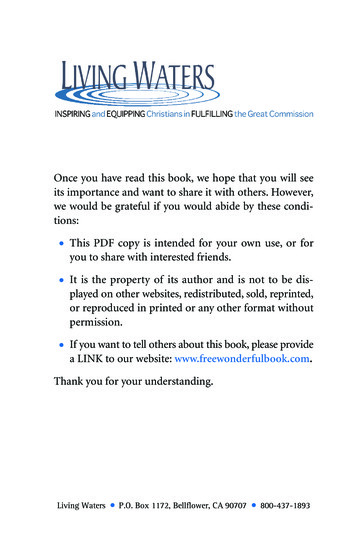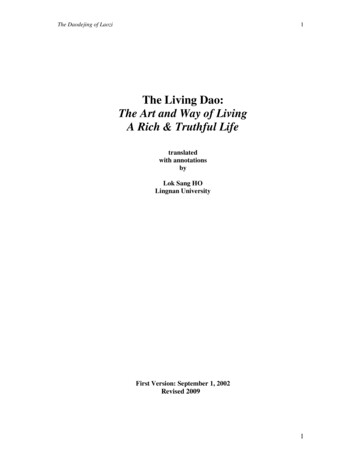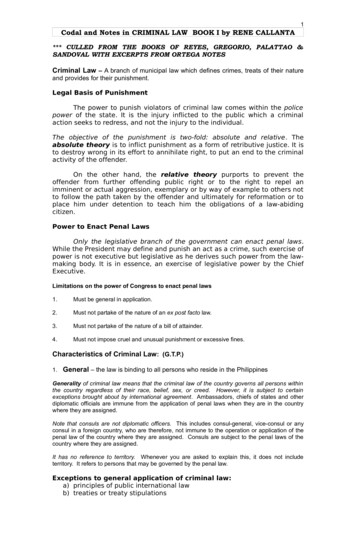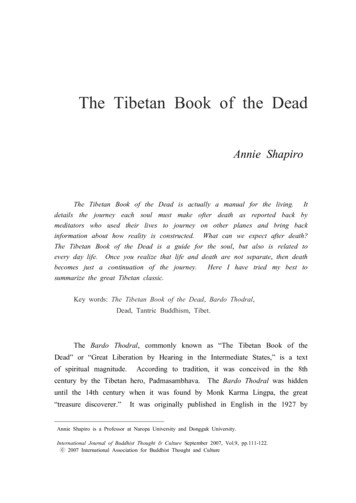
Transcription
The Tibetan Book of the DeadAnnie Shapiro1The Tibetan Book of the Dead is actually a manual for the living.Itdetails the journey each soul must make ofter death as reported back bymeditators who used their lives to journey on other planes and bring backinformation about how reality is constructed. What can we expect after death?The Tibetan Book of the Dead is a guide for the soul, but also is related toevery day life. Once you realize that life and death are not separate, then deathbecomes just a continuation of the journey.Here I have tried my best tosummarize the great Tibetan classic.Key words: The Tibetan Book of the Dead, Bardo Thodral,Dead, Tantric Buddhism, Tibet.The Bardo Thodral, commonly known as “The Tibetan Book of theDead” or “Great Liberation by Hearing in the Intermediate States,” is a textof spiritual magnitude.According to tradition, it was conceived in the 8thcentury by the Tibetan hero, Padmasambhava.The Bardo Thodral was hiddenuntil the 14th century when it was found by Monk Karma Lingpa, the great“treasure discoverer.”It was originally published in English in the 1927 byAnnie Shapiro is a Professor at Naropa University and Dongguk University.International Journal of Buddhist Thought & Culture September 2007, Vol.9, pp.111-122. 2007 International Association for Buddhist Thought and Culture
112Annie Shapiro: The Tibetan Book of the DeadEvans-Wentz in an incomplete form.These days it is widely known, andoften wildly misunderstood.To grasp the significance of this sacred Tibetan text, one must altertheir perspective.In modern Western thought, rationalism is the ruler.Inmost current paradigms, one has to see something to believe it, be able to pinit to cardboard, or keep it in a test tube.Granted, the West is not withoutits own achievements; people have traveled to the moon, created advancedmodern medicine, and induced the industrial revolution.However, Asia has been not dormant as Western technology flourished;many discoveries made in the East have been metaphysical.While the Westrevered great scientists and their achievements, the most celebrated discoverersof Tibet, India, and China were psychonauts.These people explored unseenenergetic landscapes through the mastery of meditation and yoga.Yogis andyoginis delved into the mind and drew maps of other dimensions, which ledto the creation of acupuncture charts, chakra diagrams, and such, like the firstexplorers made maps of the continents.Buddhist teachings became a bedrockof this internal exploration because of the strong emphasis on meditationpractice.In Tibet, which is relatively isolated from the rest of the world,Buddhism developed as in no other place on earth.The Bardo Thodral represents one of the peak achievements inpsychonautics, akin to the first telescopes that revealed the universe.describes the journey after death that everyone must invariably make.ItNotjust a description of the other world like Dante’s Inferno, it is also aguidebook, which everyone should take with them to the next world.Thebreadth of knowledge brought back by meditation practitioners and by Tibetan‘delogs,’ people who die and then return to this world to share theirexperiences, is detailed and profound.It can be used as a study guide for anyone living, can be read to adying person, or can be recited to a recently deceased person to help themnavigate through the next life.Ultimately, its purpose is to help peoplerecognize their true nature in the afterlife.If that is not possible, thesecondary goal is to guide them back to a favorable human birth.The basic
113International Journal of Buddhist Thought & Cultureteachings within the text are also recommended for practice in daily living.Although the Bardo Thodral has a rather foreboding reputation, it carriesa positive message.Death or change is not to be feared, but to be handledcalmly and gracefully.Life does not end after the physical body departs.Dying is just a door to new and interesting experiences, which we are able toprepare for in this lifetime.“Do not be afraid of death” is the message; it isjust a transformation to another existence, like a caterpillar turning into abutterfly.I. Historical BackgroundBefore the Maoist regime’s invasion, Tibet was one of the most isolated,peaceful, and religious countries on earth.A large percentage of thepopulation was engaged in monasticism, and the ubiquity of Buddhism was tothe extent that there was no word for “Buddhism” in the Tibetan language.There was an abundance of huge monasteries, thousands of monks, andwidespread practice of mantra and prostrations, where Buddhist practicesunique to Tibet were TibetPadmasambhava, the highland country was not a religious haven.byTibetanpeople used to be warlike, comparable to the fierce Mongolian nomads whoconquered half of the world.parts of China.At one point, Tibet’s empire even took overThe Himalayan plateau was divided into many differentwarring factions, until Padmasambhava, who was adept at memorizing esotericBuddhist texts, came from India and unified the people under Buddhism.While Tibetans revered Padmasambhava as a kind of deity, he was alsoa historical figure and a great religious teacher.According to Tibetantradition, he brought Tantric Buddhism from India to Tibet and also tamed thewarlike gods and spirits of the mountains with the teachings of Dharma.Hewrote down a number of texts and then hid them for discovery in futurecenturies.These are known as “terma” or treasure in Tibet.The Bardo
114Annie Shapiro: The Tibetan Book of the DeadThodral is one of these hidden treasures, which was discovered by the greatpractitioner Karma Lingpa six-hundred years later.Professor Robert Thurman speculates on why someone would hide areligious text for centuries.If it were really so beneficial, why wouldsomeone deprive generations of people from it?The reason, says Thurman, isbecause Tibet was not ready to confront death.In a war-like country, deathis not allowed to be acknowledged, because then people stop fighting,producing, and driving the country economically.The sacred text wasreceived at the right time for the Tibetans, when people were ready tocontemplate and “live in the clear light of death” as Thurman says (2005).As the Dalai Lama says on death, “it is not morbid to contemplate it, butrather liberating from fear, and even beneficial for the health of the living”(Thurman 1994).II. Tantric BuddhismTantra is called the left-handed path.Unlike most religious traditionswhich stress piety in order to keep negative emotions under control, Tantrasuggests that one use the negative and passionate emotions as fuel to propeloneself to evolve quickly along the spiritual path.It is said that theleft-handed path can be dangerous if someone approaches it without properunderstanding, which is why it is necessary to have a guiding teacher.Bywelcoming the scariest feelings and emotions, one can actually harness theirimmense power as fuel for spiritual growth.Buddhist teachings often utilize the metaphor of a peacock, a bird ableto ingest poison.Instead of killing the bird, the poison serves to make itsplumage even more brilliant.sensation is good or bad.This means that no emotion, experience, or“A good situation is actually a bad situation,”quoted Zen teacher Hyon Gak Sunim (Quote from Seung Sahn).This meansthat even a situation that seems terrible can be used positively when seenfrom another angle―every phenomenon is actually pure awareness.
International Journal of Buddhist Thought & Culture115In Zen Buddhism, bright color themes are used to excite the emotions,unlike in Zen Buddhism, which is starker by contrast.In Zen Buddhism, onetries to calm the passionate emotions like water on a still lake, where Tantrais more comparable to surfing on the waves of mind.In Tantra, instead ofasking oneself a question, devotion to the teacher or compassionate deities isthe most important method.Zen has less to say on Death―“When you die,just die!” said Korean Zen master Seung Sahn Sunim when asked about deathand dying (Ok Kwan 2007).Both Buddhist approaches are equally valid; theleft and right hand are two sides of the same coin, and contain the sameessence (Hyon Gak 2006-2007).Both are designed to discover the true natureof mind.The use of peaceful and frightening images describe the human psychein Tantra.Those deities are actually aspects of our own consciousness andshouldn’t be feared or idealized, but recognized as the true nature of our ownminds.Even the frightening deities with skull necklaces and many heads arecompassionately trying to wake us up; they have something to teach.Anothersacred image in Tantric Buddhism is two humans or deities in sexual embrace.This might be confusing to a Judeo-Christian mind, but this image is meant torepresent the essence of the universe, male and feminine energies comingtogether to create life.This image is actually one of the most sacred imagesin Tibetan Buddhism.Buddhist philosophy does not acknowledge the existence of a ‘soul’ inthe Judeo-Christian sense of the word.This is because consciousness has noessential nature separate from the rest of the universe.continuous stream.Buddhist scholar Alan Watts describes the “soul” as arope made of many different materials.At the top it is silk, in the middlenylon, and then cotton below that (Watts 2005).that slides down through the various materials.different knot?It is more like aThere is a knot in the ropeIs it still the same knot or aThe world Tantra actually means “thread” in Tibetan, whichsuggests a continuous awareness.
116Annie Shapiro: The Tibetan Book of the DeadIII. The Journey through the BardosBardo means “between state,” and there are many bardos in thislifetime.For example, the state between sleeping and waking is a bardo inwhich we are neither asleep nor awake.afterlife bardo.Between this life and the next is theWhat follows is a description of how one can cope with thisbetween state in order to relieve suffering, attain spiritual realization, andachieve a favorable rebirth.It is advice both for the departing person andthose around him or her to facilitate a positive experience.The Bardo Thodral describes the dying process; first the body breaksdown into its constituent elements―earth to water, water to fire, fire to wind,and wind into consciousness (Dorje 2005: 229).During this time, a dyingperson is instructed to imagine whatever compassionate deity they believe inabout one foot above the head, whether it be Buddha, Allah, Jesus, orotherwise.Imagining the essence of compassion and goodness floating abovethe head is the goal.Devotion to any specific deity is not prescribed(Dzogchen Ponlop 2007: 153).The purpose of the visualization is so the consciousness will leave fromthe top of the head, to project one’s awareness into the heavenly realms.Aperson present at that time can also put their fingers on the pressure points atthe base of the skull to direct one’s consciousness out through top of thehead.“The Tibetan Book of the Dead” instructs one to remain calm andpositive as the moment of transcendence approaches.intention to remain calm will help greatly.mantras such as “Om Mani Padme Hung.”Even just creating theAlso, it is suggested to reciteTo keep a loving mind in everymoment is important, especially before dying, as the state at the time of deathwill set the trajectory into the Bardos.Dzogchen Ponlop Rinpoche is a modern day master of Buddhist Tantra.In his book, “Mind Beyond Death,” he gives advice to the loved ones of thedying person.He says that one of the best things to do is to read the“Tibetan Book of the Dead” to the dying person, and recite it again afterconsciousness has left the body.This way they can be guided through the
117International Journal of Buddhist Thought & CultureBardo states.He also notes, immediately after death, people should not cryor be depressed, as this can disturb the spirit of the departed.They shouldtreat the possessions of the person respectfully, as not to cause any upset.Rather than crying and being depressed, we should maintain an atmosphere ofsupport and loving kindness (Dzogchen Ponlop 2007: 125).The Bardo Thodral tells us that immediately after death we experience“the luminosity” or, “inner radiance of the first intermediate state” (Dorje2005).The luminosity described appears right after the consciousness leavesthe body, and lasts, according to Thurman, about as long as it takes to eat ameal (Thurman 2005).The naked luminosity is perhaps the “white light atthe end of the tunnel,” which so many people describe in near-deathexperiences.It could be called God, pure consciousness, or awareness.Tibet, it is called “the nature of mind,” among many other descriptors.InWhatthe Bardo Thodral points out is this clear luminosity is one and the same asour true nature.The luminous consciousness is our true essence.If one canrecognize that, one can attain state of “rainbow body” and move beyondsamsara, or suffering, completely.opportunity for this reason.The Tibetans see death as a greatIt is easier to attain enlightenment in this statethan in the afterlife (Thurman 1994: 121).After this state, if one does not recognize the pure luminosity, onemoves into the “between stages,” or bardos.After the luminosity stage, theconsciousness of the being is able to perceive and move in the world withouttheir body, like a ghost.At this point, the soul may see those people whoare close to him or her in mourning.This may cause suffering for the beingbecause they want their loved ones to know that they are not dead, but stillalive.However, at this point, the soul should completely let go of attachmentto the past life, the people and the places in it, in order to embark fully on anew journey (McLean 1999).The Bardo Thodral reads,O, Child of Buddha Nature, that which is called death has nowarrived.Therefore you should adopt an altruistic motivation andconcentrate your thinking as follows: ‘I have arrived at the time of
118Annie Shapiro: The Tibetan Book of the Deaddeath, so now, relying on the process of death, I will single-mindedlycultivate an altruistic motivation. I will meditate on generation ofloving kindness and compassion and altruistic intention to attainenlightenment. For the benefit of all sentient beings, who are alllimitless as space, I must attain perfect buddhahood’ (Dorje 2005:230).As the consciousness being releases attachments to this life, at this stageof the afterlife, one becomes extremely powerful.Consciousness can goanyplace in heaven or earth just by thinking about it.Because one has suchpower in this state, one should remember to keep an altruistic mind, becauseit is possible to accomplish feats that may have been impossible during life(McLean 1999).The after-death process is said to take 49 earth days tocomplete, depending on the individual’s karma, though the way the soulexperiences the passage of time is relative.The exception to the 49 days isif someone manages to attain enlightenment immediately after death.Then,they will be instantly reborn in the pure lands or another birth of theirchoosing.In the Bardo, both peaceful and wrathful apparitions begin to emerge.Because there are so many deities in Tibetan tradition, the descriptions of whoyou may meet in the afterlife are quite colorful.For example, the BardoThodral reads,The transcendent lord Ratnasambhava will dawn before you, hisbody yellow in color, holding in his right hand a jewel, seated on ahorse throne and embraced by his supreme consort Mamaki. . [alight] will emanate from the heard of Ratnasambhava and his consortwill shine piercingly before you at the level of your heart with suchbrilliance that your eyes cannot bear it. . at that time, abandon yourfear of the yellow light and recognize it as pristine awareness.Relax and abide directly within it, in a state of non-activity. Againand again, have confidence in it!Be drawn to it with lovingdevotion (Dorje 2005: 240).The descriptions of these gods and goddesses span the range .Everythingone
International Journal of Buddhist Thought & Culture119encounters is basically a manifestation of one’s own mind.Without beingcaged in the body, the subconscious mind is projected completely, as in adream.While a person of Tibetan upbringing may very well see the myriadof deities described, the author feels that one shouldn’t take these descriptionsliterally, but realize they are aspects of consciousness that we already knowquite intimately.However, these states of mind will be much more vivid inthe afterlife state (Dzogchen Ponlop 2007: 124).It is said that the lord of death will appear and judge the soul for allgood and bad deeds, but the Bardo Thodral reminds us, do not be afraid.There is nothing that can harm you because you are pure consciousness.Onthe subject of these appearances, it is said, they “have emerged from yourown brain!Do not fear them!Do not be terrified!Do not hate them!Feel delight!Recognize them as an image of your own awareness” (Thurman1994: 156).Basically, whatever appears after death is no different than yourown mind’s projections.Be relaxed, do not be afraid, and try to recognizethese creations as your own pure nature.These appearances are all the karma, or mental patterns from the mindstream, from our deep unconscious minds.Unlike Christianity, which suggeststhat a person will either go to heaven or hell eternally depending on theindividual’s good and bad deeds, in Buddhism, it is possible that both realmsof heaven and hell will appear. These also are only temporary, so one shouldnot get attached to any state, but just let them appear and experience themwithout loving or hating them.One should keep an altruistic mind, and keepthe goal of attaining a precious human rebirth.In death, as in life, oneshould not give way to fear, hatred, or ignorance.IV. The Six RealmsAfter the appearance of the various psychical manifestations run theircourse, the lights of the six realms appear.next rebirth.Here, the soul can choose theThese lights are not as bright as the dazzling appearances
120Annie Shapiro: The Tibetan Book of the Deadbefore, but this is just as important as the spirit can choose its next rebirth.According to Buddhism, everyone reincarnates unless they have becomecompletely enlightened during the Bardo stage.Even enlightened masterschoose to reincarnate, because they are Bodhisattvas who have vowed to bereborn until every being is saved (McLean 1999).For each realm, there is a different colored light.The grey smoky lightrepresents the hell realm, where anger is the dominant emotion.The yellowlight represents the realm of the hungry ghosts, which is characterized bycraving, and the green light is that of the animal realm.that of the human realm.The blue light isThe red light is the realm of the assuras, jealousgods who are more powerful than humans; the white light is that of the godlyrealm, which is said to be heavenly, but is characterized by pride.Althoughit may seem more desirable to be reborn in the gods’ realm, it is said thatthe human realm is the best one, because here exists a mix of pleasure andsuffering to make one’s consciousness strive to evolve (Dzogchen Ponlop2007: 211-217).V. Attaining a Human RebirthIn order to attain a human rebirth, one is supposed to go towards theblue light.Another suggestion that could potentially help attain this rebirth isvisualizing the guru and consort in union.As the spirit is drawn to aparticular rebirth, it should look for a good situation, including loving parentsand an environment where there is leisure time to practice meditation orcontemplation.One will see a human couple copulating and will be drawn tothem at the moment of conception.“They will be drawn to human parentslike a magnet” says Ch’an Master Sheng-yen.This couple will become theperson’s new parents.While the Tibetan teaching on this subject can seem tremendouslyesoteric, with its ornate and complex pantheon, it also points to the fact thatthe mind is the most powerful in deciding one’s experience.Thus, a natural
121International Journal of Buddhist Thought & Cultureand relaxed stance is important.Also making positive aspirations, feelingcompassion or devotion to loving kindness are perhaps more important thanany information we can keep with us.VI. The Bardo Thodral and Everyday LifeWhat relevance has the Bardo Thodral beyond just a guide book for theafterlife?While the descriptions of the bardos are lush and detailed, theinstructions always point to a few simple ideas, like strength, courage, anddevotion to compassion.If we have cultivated a positive, altruistic mindduring this lifetime, and have acted kindly towards others, then the afterlifeand next rebirth will reflect this.Cultivating the mind means being able tostay calm in a trying situation, to relax, and not give way to fear.Todevelop loving kindness, or metta, for others is actually the point ofmeditation practice (Pannayaboga 2007: Personal conversation).When wemake friends with our intense emotions instead of running from them, thennothing can harm us (Dzogchen Ponlop 2007: 43).The Bardo Thodral tells us it is possible to recognize that allphenomenon is actually none other than our true nature of mind; benevolent,compassionate, and luminous.All you have to do is just trust your ownuniversal nature, which has been there all along.Every moment of life wehave a choice; to remain asleep or to choose consciousness and finally wakeup (Wu Bong 2007).ReferencesDorje, Gyurme2005Dzogchen Ponlop(Rinpoche)2007The Tibetan Book of the Dead. NY: PenguinClassics.Mind Beyond Death. Ithaca NY: Snow LionPublications.
122Annie Shapiro: The Tibetan Book of the DeadHyon Gak(Sunim)2006-2007McLean, Barrie1999Ok Kwan (Sunim)2007Pannyaboga(Burmese Monk)2007Sheng-yen(Ch’an Master)1993Thurman, R.19942005Watts, Alan2005Wu Bong(Zen Master)2007Personal conversations, e-mail and Dharma talks.The Tibetan Book of the Dead―A way of life(Video). December 21.Dharma talk at Hwa Gye Sa.Dharma talk. November.Zen Wisdom: Knowing an Doing. NY: DharmaDrum Publications.The Tibetan Book of the Dead. NY: Bantam Books.The Jewel in the Enlightenment Engine of Tibet.NY: Free Press.Radio Broadcast KGNU Radio Boulder. Colorado.Dharma talk at Hwa Gye Sa. November.
The Tibetan Book of the Dead is actually a manual for the living. It . is not allowed to be acknowledged, because then people stop fighting, producing, and driving the country economica
